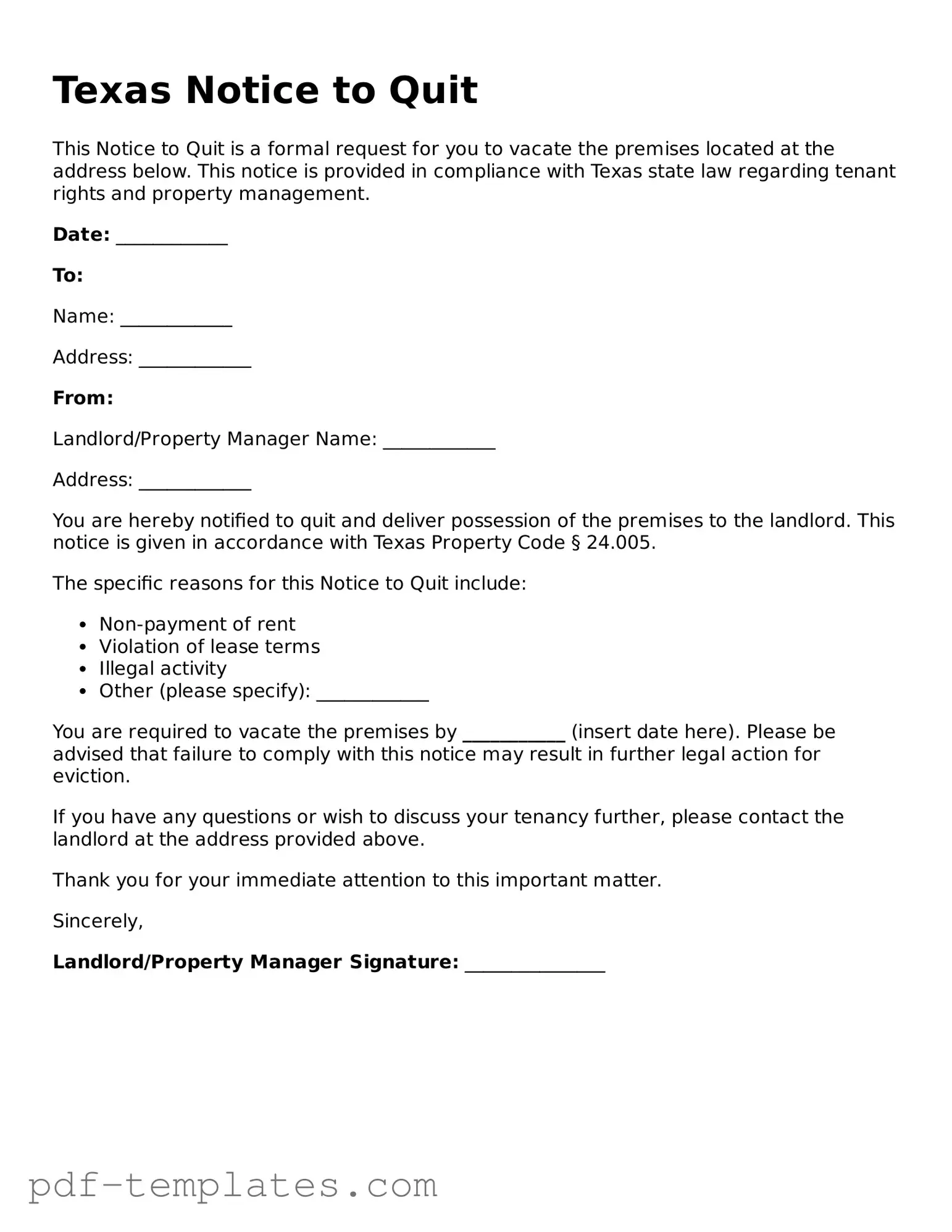The Texas Notice to Quit form shares similarities with the Eviction Notice, commonly used across many states. Both documents serve as formal notifications to tenants, informing them that they must vacate the premises. The Eviction Notice typically outlines the reasons for eviction, such as non-payment of rent or lease violations, and provides a timeline for the tenant to respond or leave. Like the Texas Notice to Quit, it is a crucial step in the eviction process, ensuring that tenants are aware of their obligations and the potential consequences of failing to comply.
Another document that resembles the Texas Notice to Quit is the Lease Termination Notice. This notice is issued by landlords to terminate a rental agreement, either at the end of the lease term or for other reasons. Both documents serve to communicate the intent to end the tenancy, but the Lease Termination Notice often provides a more extended timeline for the tenant to vacate. While the Texas Notice to Quit may be used in cases of immediate eviction, the Lease Termination Notice allows for a smoother transition at the end of a lease period.
The Pay or Quit Notice is another document similar to the Texas Notice to Quit. This notice is specifically aimed at tenants who have failed to pay rent on time. It informs tenants that they must either pay the outstanding rent or vacate the property within a specified timeframe. Both notices emphasize the importance of compliance and outline the consequences of not taking action. The Pay or Quit Notice is a critical tool for landlords to address non-payment while giving tenants a clear path to remedy the situation.
Understanding your rights and responsibilities as a tenant is crucial when dealing with rental agreements. Familiarizing yourself with documents such as the Texas Notice to Quit can significantly impact your situation. For those interested in broader legal powers, a General Power of Attorney form allows individuals to empower trusted agents to handle various legal matters on their behalf, highlighting the importance of legal documentation in both renting and broader legal contexts.
The Cure or Quit Notice is yet another document that parallels the Texas Notice to Quit. This notice is issued when a tenant violates a lease term, such as having unauthorized pets or causing property damage. It provides the tenant with an opportunity to correct the violation within a specified period. Like the Texas Notice to Quit, the Cure or Quit Notice emphasizes the need for tenants to take immediate action to avoid eviction. Both documents aim to protect the landlord's rights while giving tenants a chance to rectify their behavior.
The Conditional Quit Notice is similar to the Texas Notice to Quit in that it also addresses lease violations. However, this notice includes specific conditions that the tenant must meet to avoid eviction. For instance, if a tenant has repeatedly violated a noise policy, the Conditional Quit Notice may require them to cease such behavior within a certain timeframe. Both documents serve as warnings, but the Conditional Quit Notice outlines specific actions needed to maintain tenancy, making it a proactive approach to landlord-tenant disputes.
The Notice of Non-Renewal is another document that shares characteristics with the Texas Notice to Quit. This notice is issued by landlords when they decide not to renew a lease agreement. While the Texas Notice to Quit may be used in more urgent situations, the Notice of Non-Renewal typically provides tenants with advance notice, allowing them to prepare for their move. Both documents serve to inform tenants of changes in their rental status, ensuring transparency and clarity in the landlord-tenant relationship.
The Rent Demand Notice is closely related to the Texas Notice to Quit, focusing specifically on overdue rent. This notice demands payment and often includes a deadline for the tenant to pay the outstanding amount. Similar to the Texas Notice to Quit, it serves as a formal request for action, emphasizing the importance of timely rent payments. Both documents are vital in the eviction process, as they establish a clear communication channel between landlords and tenants regarding financial obligations.
The Notice to Enter is another document that has similarities with the Texas Notice to Quit, albeit with a different purpose. This notice is used by landlords to inform tenants of their intention to enter the rental property, often for maintenance or inspections. While the Texas Notice to Quit signals the end of a tenancy, the Notice to Enter ensures that tenants are aware of their rights and the landlord's responsibilities. Both documents aim to foster communication and respect within the landlord-tenant relationship.
Lastly, the Habitability Notice can also be compared to the Texas Notice to Quit. This notice is issued by tenants when they believe their living conditions are uninhabitable due to issues like lack of heat or water. It demands that landlords address these problems or face potential legal action. While the Texas Notice to Quit is a landlord-initiated document, the Habitability Notice empowers tenants to advocate for their rights. Both notices highlight the importance of maintaining a safe and livable environment for all parties involved.
